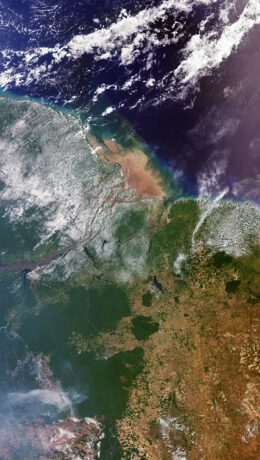 The Copernicus Sentinel-3 mission collected this image over northern Brazil, where the Amazon River meets the Atlantic Ocean.
The Copernicus Sentinel-3 mission collected this image over northern Brazil, where the Amazon River meets the Atlantic Ocean.
Originating in the Andes, the Amazon River flows east, traversing six South American countries before reaching the northeast coast of Brazil, where it empties into the Atlantic. The sediment-laden river appears brown as it flows to the open ocean in the upper center of the image.
The coast is surrounded by a muddy-brownish plume of suspended sediment, carried from upstream to the maze of channels constituting the 270-kilometer-wide mouth of the Amazon. Discharge from the Amazon River, the Amazon plume, accounts for around 20 percent of the global input of freshwater into the ocean from Earth’s land surfaces.
The Amazon has more than 1,000 tributaries, some of which are visible as thin, winding lines entering the river from the south, including the Tapajos River to the west and, further downstream, the Xingu River. The dark color of these sediment-poor tributaries contrasts with the brownish sediment-rich Amazon waters.
The Tapajós-Xingu area is an important moist forest ecoregion. However, the Transamazon Highway, discernible as a brown line traversing this area, has spurred urbanization.
The color of the land varies, ranging from the deep green of dense, untouched vegetation to various tones of brown, highlighting the contrast between the rainforest and sprawling cultivation—the fishbone-like patterns particularly visible along the highway.
Light green hues across the image denote agricultural areas, which were once covered by rainforest. The somewhat geometric shapes, which appear dark green and brown, result from forest clear-cutting.
Image Credit: Contains modified Copernicus Sentinel data (2022), processed by ESA

